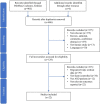Effects of non-invasive neurostimulation on autism spectrum disorder: A systematic review
- PMID: 36405911
- PMCID: PMC9666381
- DOI: 10.3389/fpsyt.2022.989905
Effects of non-invasive neurostimulation on autism spectrum disorder: A systematic review
Abstract
Non-invasive neurostimulation techniques (NIBS) have shown benefits in psychiatric conditions. While in ASD patients, no guideline has so-far been recommended on these techniques due to a lack of high-quality synthetic evidence. Here, a comprehensive search from database inception onward was conducted in PubMed, EMBASE, and Cochrane library. Sham-controlled studies assessing the effects of NIBS in ASD patients were identified. After screening, twenty-two studies were included. A total of 552 patients were involved, and the sample size ranged from 5 to 78 patients. Although an iteration from exploratory attempts to more strictly designed trials has been seen to evaluate the efficacy of NIBS on ASD, further trials should also be needed to enable the clinicians and researchers to reach any consensus.
Systematic review registration: [https://www.crd.york.ac.uk/prospero/display_record.php?ID=CRD42021292434], identifier [CRD42021292434].
Keywords: autism spectrum disorder; meta-analysis; noninvasive neurostimulation; systematic review; transcranial direct current stimulation; transcranial magnetic stimulation.
Copyright © 2022 Zhang and Zhang.
Conflict of interest statement
The authors declare that the research was conducted in the absence of any commercial or financial relationships that could be construed as a potential conflict of interest.
Figures
Similar articles
-
Non-invasive brain stimulation for patient with autism: a systematic review and meta-analysis.Front Psychiatry. 2023 Jun 29;14:1147327. doi: 10.3389/fpsyt.2023.1147327. eCollection 2023. Front Psychiatry. 2023. PMID: 37457781 Free PMC article. Review.
-
Effects of Non-invasive Neurostimulation on Autism Spectrum Disorder: A Systematic Review.Clin Psychopharmacol Neurosci. 2020 Nov 30;18(4):527-552. doi: 10.9758/cpn.2020.18.4.527. Clin Psychopharmacol Neurosci. 2020. PMID: 33124586 Free PMC article. Review.
-
Prevalence of Adverse Effects Associated With Transcranial Magnetic Stimulation for Autism Spectrum Disorder: A Systematic Review and Meta-Analysis.Front Psychiatry. 2022 May 23;13:875591. doi: 10.3389/fpsyt.2022.875591. eCollection 2022. Front Psychiatry. 2022. PMID: 35677871 Free PMC article.
-
Non-invasive brain stimulation associated mirror therapy for upper-limb rehabilitation after stroke: Systematic review and meta-analysis of randomized clinical trials.Front Neurol. 2022 Jul 19;13:918956. doi: 10.3389/fneur.2022.918956. eCollection 2022. Front Neurol. 2022. PMID: 35928134 Free PMC article.
-
Effects of non-invasive brain stimulation in children and young people with psychiatric disorders: a protocol for a systematic review.Syst Rev. 2021 Mar 11;10(1):76. doi: 10.1186/s13643-021-01627-3. Syst Rev. 2021. PMID: 33706788 Free PMC article.
Cited by
-
Commercial Wearables for the Management of People with Autism Spectrum Disorder: A Review.Biosensors (Basel). 2024 Nov 15;14(11):556. doi: 10.3390/bios14110556. Biosensors (Basel). 2024. PMID: 39590015 Free PMC article. Review.
-
Feasibility, safety, and efficacy of high-dose intermittent theta burst stimulation in children with autism spectrum disorder: study protocol for a pilot randomized sham-controlled trial.Front Psychiatry. 2025 Mar 31;16:1549982. doi: 10.3389/fpsyt.2025.1549982. eCollection 2025. Front Psychiatry. 2025. PMID: 40230821 Free PMC article.
-
Non-invasive brain stimulation for patient with autism: a systematic review and meta-analysis.Front Psychiatry. 2023 Jun 29;14:1147327. doi: 10.3389/fpsyt.2023.1147327. eCollection 2023. Front Psychiatry. 2023. PMID: 37457781 Free PMC article. Review.
References
-
- Begum R, Mamin FA. Impact of autism spectrum disorder on family. Autism Open Access. (2019) 9:244. 10.35248/2165-7890.19.9.244 - DOI
Publication types
LinkOut - more resources
Full Text Sources



